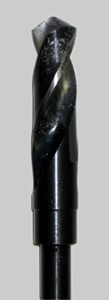- 01: Introduction
- 02: History
- 03: Propellants, Firearms, and Ammunition Development
- 04: Modern Firearms Manufacture
- 05: Small Arms Ammunition
- 06: Evidence Handling Procedures
- 07: Equipment and Instrumentation
- 08: Examination of Firearms
- 09: Cartridge and Shotshell Examination
- 10: Characterization and Evaluation of Fired Projectiles
- 11: Bullet Comparison and Identification
- 12: Gunshot Residue and Distance Determination
- 13: Toolmark Identification
- 14: Communicating Results
- Resources


Deep Hole Drilling
Home > Modern Firearms Manufacture > Rifled Barrels > Deep Hole Drilling
The initial steel bar has a straight exterior profile. This allows for better alignment in boring and rifling machines and the stiffness needed to resist deformation due to heating. The first step is the critical deep-drill operation to produce a straight hole the entire length of the barrel. The diameter of the hole depends on the downstream rifling equipment. For cut rifling, the hole is smaller than the bullet that will be fired; for forged rifling, the hole must be larger.
The drilling operation requires excellent support of all tooling and the barrel stock to produce a straight hole. Drilling speed is dictated by the diameter of the hole. A large diameter hole can be drilled faster than a small diameter hole because the stiffness of the larger drill shaft resists warping.

Deep hole drill bit
| Note |
| The speed of drilling was a major factor in the introduction of mass-produced .17 caliber firearms. Prior to the year 2000, drilling the .17 caliber bore required painfully slow drilling and was generally performed only by small, custom barrel makers. The major manufacturers developed new technology to make tiny straight holes at a production rate acceptable to their cost requirements. |
Drilling produces significant marks useful to the firearms examiner. Chips produced by drilling often nick the surface before lubricants flush them from the hole, adding to the randomness of the marks. Drilling marks run perpendicular to the axis of the bore, leaving little chance of carry-over of marks from one barrel to the next.
Typically, gun drills are sized to produce a finished hole that is a few ten-thousandths of an inch under the desired diameter. The next operation removes this small discrepancy.

Click here to watch a video on deep hole drilling.




